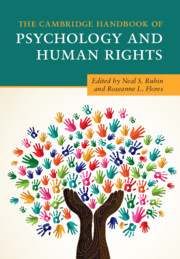Book contents
- The Cambridge Handbook of Psychology and Human Rights
- The Cambridge Handbook of Psychology and Human Rights
- Copyright page
- Dedication
- Contents
- Figures
- Tables
- Boxes
- Contributors
- Acknowledgments
- The Core International Human Rights Instruments and Their Monitoring Bodies
- Universal Human Rights Instruments
- Sustainable Development Goals
- Glossary of United Nations and Psychology Acronyms in the Handbook
- Introduction
- Part I History of Human Rights
- Part II The Intersection of Psychology and Human Rights
- Part III Contemporary Issues in Psychology and Human Rights
- Part IV Teaching, Research, and Training in Psychology and Human Rights
- Part V Future Directions
- 36 Human Rights and Reconciliation
- 37 The Australian Psychological Society’s Apology to Aboriginal and Torres Strait Islander People
- 38 The Role of Scientific Societies in Promoting and Protecting Human Rights and the Example of the American Psychological Association
- 39 Human Rights, Psychology, and Artificial Intelligence
- 40 Psychology, Human Rights, and the Implementation of the United Nations’ 2030 Agenda for Sustainable Development
- Index
- References
39 - Human Rights, Psychology, and Artificial Intelligence
from Part V - Future Directions
Published online by Cambridge University Press: 02 October 2020
- The Cambridge Handbook of Psychology and Human Rights
- The Cambridge Handbook of Psychology and Human Rights
- Copyright page
- Dedication
- Contents
- Figures
- Tables
- Boxes
- Contributors
- Acknowledgments
- The Core International Human Rights Instruments and Their Monitoring Bodies
- Universal Human Rights Instruments
- Sustainable Development Goals
- Glossary of United Nations and Psychology Acronyms in the Handbook
- Introduction
- Part I History of Human Rights
- Part II The Intersection of Psychology and Human Rights
- Part III Contemporary Issues in Psychology and Human Rights
- Part IV Teaching, Research, and Training in Psychology and Human Rights
- Part V Future Directions
- 36 Human Rights and Reconciliation
- 37 The Australian Psychological Society’s Apology to Aboriginal and Torres Strait Islander People
- 38 The Role of Scientific Societies in Promoting and Protecting Human Rights and the Example of the American Psychological Association
- 39 Human Rights, Psychology, and Artificial Intelligence
- 40 Psychology, Human Rights, and the Implementation of the United Nations’ 2030 Agenda for Sustainable Development
- Index
- References
Summary
This chapter provides several examples of how artificial intelligence–based technologies are changing human rights practice, from detecting abuses to dealing with their aftermath. It especially focuses on three critical issues where the field of psychology can address a spectrum of human rights needs. The first is the psychological impact of the application of AI within society, specifically the positive and negative impacts of its use within humanitarian and human rights work. The second is the risk of its application perpetuating bias and discrimination. The third is the spread of disinformation and the manipulation of public opinion. While the chapter touches on all three issues, it particularly focuses on the third because of the central role disinformation is currently playing in everything from democratic governance to daily life. For each of these issues, the chapter summarizes how psychological research might provide critical insights for mitigating harm. The chapter closes with priority considerations for minimizing the negative effects of AI on human rights.
Keywords
- Type
- Chapter
- Information
- The Cambridge Handbook of Psychology and Human Rights , pp. 583 - 590Publisher: Cambridge University PressPrint publication year: 2020



